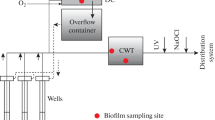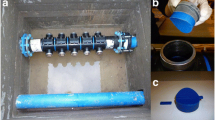Abstract
The influence of natural organic substances and iron hydroxides on in vitro biofilm formation by groundwater microorganisms was assessed. The combination of these compounds stimulates the formation of large mucosal biofilms that absorb insoluble iron hydroxide particles. Organic substances are important regulators of biofilm formation. Therefore, the location of biofilms in pore space increases the risks of biocolmatage of this space.
Similar content being viewed by others
Abbreviations
- BF:
-
biofilm
- YE:
-
yeast extract
- OD:
-
optical density
- FPA:
-
fish-peptone agar
- T-20:
-
Caulobacter sp.T-20 strain
References
Nikolaev, Yu.A. and Plakunov, V.K., Biofilm—“City of microbes” or an analogue of multicellular organisms?, Microbiology (Moscow), 2007, vol. 76, no. 2, pp. 149–163.
Parfenova, V.V., Mal’nik, V.V., Boiko, S.M., Sheveleva, N.G., Logacheva, L.F., Evstigneeva, T.D., Suturin, A.N., and Timoshkin, O.A., Communities of hydrobionts developing at the water–rock interface in Lake Baikal, Russ. J. Ecol., 2008, vol. 39, no. 3, pp. 198–204.
Flemming, H.-C., Microbial Biofouling: Unsolved Problems, Insufficient Approaches, and Possible Solutions, Berlin, Heidelberg: Springer-Verlag, 2011.
Flemming, H.-C., Why Microorganisms Live in Biofilms and the Problem of Biofouling, Berlin, Heidelberg: Springer-Verlag, 2008.
Kvartenko, A.N. and Govorova, Zh.M., Upgraded technologies for complex conditioning of ground water, Vestnik MGSU, 2013, no. 5, pp. 118–123.
Karmalov, A.I. and Filimonova, S.V., Analysis of the causes of clogging and corrosion of equipment of water supply wells under increased anthropogenic pressure, Vodosnabzhen. San. Tekhnika, 2011. no. 9 (1), pp. 16–20.
Kulakov, V.V. and Kondrat’eva, L.M., Biogeochemical aspects of purification of groundwater of the Priamurye, Tikhookean. Geol., 2008. no. 17 (1), pp. 109–118.
Costerton, J.W., Lewandowski, Z., Caldwell, D.E., Korber, J.W., and Lappin-Scott, H.M., Microbial biofilms, Annu. Rev. Microbiol., 1995, no. 49, pp. 711–745.
Costerton, J.W., The Biofilm Primer, Berlin, New York: Springer, 2007.
Mencha, M.N., Iron bacteria in the systems of drinking water supply from underground sources, Vodosnabzhen. San. Tekhn., 2006, no. 7, pp. 25–32.
Schlegel, H.G., General Microbiology, 6th ed., Cambridge: Cambridge Univ. Press, 1986.
Zavarzin, G.A., Lektsii po prirodovedcheskoi mikrobiologii (Lectures on Natural Sciences Microbiology), Moscow: Nauka, 2003.
Bukreeva, V.Yu., Grabovich, M.Yu., Eprintsev, A.T., and Dubinina, G.A., Sorption of colloidal compounds of iron and manganese oxides with the aid of iron bacteria in the sand loadings of treatment facilities of water-lifting stations, Sorbtsion. Khromatograf. Prots., 2009, vol. 9, no. 4, pp. 506–514.
Potekhina, Zh.S., Metabolizm Fe(III) vosstanavlivayushchikh bakterii (Metabolism of Fe(III) Reducing Bacteria), Tolyatti: IEVB RAN, 2006.
Nealson, K.H. and Myers, C.R., Microbial reduction of manganese and iron: new approaches to carbon cycling, Appl. Environ. Microbiol., 1992, vol. 59, pp. 439–443.
Schroder, I., Johnson, E., and de Vries, S., Microbial ferric iron reductases, FEMS Microbiol. Rev., 2003, vol. 27, nos. 2–3, pp. 427–447.
Lovley, D.R., Dissimilatory Fe(III) and Mn(IV) reduction, Microbiol. Rev., 1991, vol. 55, pp. 259–287.
Lovley, D.R., Holmes, D.E., and Nevin, K.P., Dissimilatory Fe(III) and Mn(IV) reduction, Adv. Microb. Physiol., 2004, vol. 49, pp. 219–286.
Shi, L., Squier, T.C., Zachara, J.M., and Fredrickson, J.K., Respiration of metal (hydr)oxides by Shewanella and Geobacter: a key role for multichaem c-type cytochromes, Mol. Microbiol., 2007, vol. 65, no. 1, pp. 12–20.
Loughlin, E.J., Gorski, C.A., Scherer, M.M., Boyanov, M.I., and Kemner, K.M., Effects of oxyanions, natural organic matter, and bacterial cell numbers on the bioreduction of lepidorocite (gamma-FeOOH) and the formation of secondary mineralization products, Environ. Sci. Technol., 2010, vol. 44, no. 12, pp. 4570–4576.
Nevin, K.P. and Lovley, D.R., Mechanisms for accessing insoluble Fe(III) oxide during dissimilatory Fe(III) reduction by Geothrix fermentans, Appl. Environ. Microbiol., 2002, vol. 68, no. 5, pp. 2294–2299.
Lovley, D.R., Fraga, J.L., Blunt-Harris, E.L., Hayes, L.A., Phillips, E.J., and Coates, J.D., Humic substances as a mediator for microbially catalyzed metal reduction, Acta Hydrochim. Hydrobiol., 1998, vol. 26, pp. 152–157.
Newman, D.K., Newman, D.K., and Kolter, R., A role for excreted quinones in extracellular electron transfer, Nature, 2000, vol. 405, pp. 93–97.
Cullimore, D.R., Microbiology of Well Biofouling, Boca Raton, FL: CRS Press, 1999.
Walter, D.A., Geochemistry and Microbiology of IronRelated Well-Screen Encrustation and Aquifer Biofouling in Suffolk Conty. Water-Resources Investigations Report 97-4032, New York: Coram, 1997.
Chapelle, F.H. and Lovley, D.R., Competitive exclusion of sulfate reduction by Fe(III) reducing bacteria: a mechanism for producing discrete zones of high-iron ground water, Ground Water, 1992, vol. 30, pp. 29–36.
Strelkova, E.A., Pozdnyakova, N.V., Zhurina, M.V., Plakunov, V.K., and Belyaev, S.S., Role of the extracellular polymer matrix in resistance of bacterial biofilms to extreme environmental factors, Microbiology (Moscow), 2013, vol. 82, no. 2, pp. 119–125.
Mazzon, R.R., Mazzon, R.R., Lang, E.A., Braz, V.S., and Marques, M.V., Characterization of Caulobacter crescentus response to low temperature and identification of genes involved in freezing resistance, FEM Microbiol. Lett., 2008, vol. 288, no. 2, pp. 178–185.
Moldoveanu, A.M., Bacterial biofilms utilization of low concentration of organic matter on hydrophile surfaces submerged in seawater, Sci. Annals of Al. I. Cuza University, 2011, vol. 12, no. 4, pp. 165–175.
Sutherland, I.W., Biotechnology of Microbial Exopolysaccharides, Cambridge: University Press, 1990.
Author information
Authors and Affiliations
Corresponding author
Additional information
Original Russian Text © L.M. Kondratyeva, Z.N. Litvinenko, 2014, published in Biotekhnologiya, 2014, No. 3, pp. 73–82.
Rights and permissions
About this article
Cite this article
Kondratyeva, L.M., Litvinenko, Z.N. Biofilm formation by groundwater microbial complexes in vitro. Appl Biochem Microbiol 51, 893–902 (2015). https://doi.org/10.1134/S0003683815090057
Received:
Published:
Issue Date:
DOI: https://doi.org/10.1134/S0003683815090057




